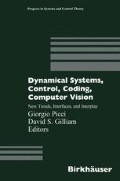Abstract
In a large number of segmentation problems, the number of different objects or classes present in the image is known a priori. Examples are magnetic resonance images of the cortex and SAR data. A technique to introduce this prior knowledge into the segmentation process is presented and analyzed in this paper. The basic idea is to perform edge preserving anisotropic smoothing of posterior probabilities, computed via Bayes rule, followed by an independent pixelwise maximum aposterior probability (MAP) classification. In this paper, we describe the technique and develop the mathematical theory underlying it. We demonstrate that prior anisotropic smoothing of the posterior probabilities yields the MAP solution of a discrete Markov random field (MRF) with a non-interacting, analog discontinuity field. In contrast, isotropic smoothing of the posterior probabilities is equivalent to computing the MAP solution of a single, discrete MRF using continuous relaxation labeling. Combining a discontinuity field with a discrete MRF is important as it allows the disabling of clique potentials across discontinuities. Furthermore, explicit representation of the discontinuity field suggests new algorithms that incorporate properties like hysteresis and non-maximal suppression.
This work was partially supported by ONR Grant N00014-97-1-0509, ONR Young Investigator Program Award, and NSF-LIS.
Access this chapter
Tax calculation will be finalised at checkout
Purchases are for personal use only
Preview
Unable to display preview. Download preview PDF.
References
L. Alvarez, P. L. Lions, and J. M. Morel. Image selective smoothing and edge detection by nonlinear diffusion. SIAM J. Numerical Analysis, 29: 845–866, 1992.
J. Besag. On the statistical analysis of dirty pictures. J. Royal Statistical Society, 48: 259–302, 1986.
M. Black and A. Rangarajan. On the unification of line processes, outlier rejection, and robust statistics with applications in early vision. Infi J. Computer Vision, 19 (1): 57–91, 1996.
M. Black, G. Sapiro, D. Marimont, and D. Heeger. Robust anisotropic diffusion. IEEE Trans. Image Processing, March 1998.
O. D. Faugeras and M. Berthod. Improving consistency and reducing ambiguity in stochastic labeling: an optimization approach. IEEE Trans. Pattern Analysis and Machine Intelligence, 3: 412–423, 1981.
S. Geman and D. Geman. Stochastic relaxation, Gibbs distributions, and the Bayesian restoration of images. IEEE Trans. Pattern Analysis and Machine Intelligence, 6 (6): 721–742, 1984.
G. Gerig, O. Kubler, R. Kikinis, and F. A. Jolesz. Nonlinear anisotropic filtering of MRI data. IEEE Trans. Medical Imaging, 11: 221–232, 1992.
S. Haker, G. Sapiro, and A. Tannenbaum. Knowledge based segmentation of SAR data. Proc. IEEE-ICIP 98, Chicago, October 1998.
R. A. Hummel and S. W. Zucker. On the foundations of relaxation labeling processes. IEEE Trans. Pattern Analysis and Machine Intelligence, 5 (2): 267–286, 1983.
S. Kirkpatrick, C. D. Gellatt, and M. P. Vecchi. Optimization by simulated annealing. Science, 220: 671–680, 1983.
S. Z. Li, H. Wang, and M. Petrou. Relaxation labeling of Markov random fields. In Int’l Conf. Pattern Recognition, pages 488–492, 1994.
P. Perona and J. Malik. Scale-space and edge detection using anisotropic diffusion. IEEE Trans. Pattern Analysis and Machine Intelligence, 12 (7): 629–639, 1990.
A. Rosenfeld, R. Hummel, and S. Zucker. Scene labeling by relaxation operations. IEEE Trans. Systems, Man, and Cybernetics, 6 (6): 420–433, 1976.
P. C. Teo, G. Sapiro, and B. A. Wandell. Creating connected representations of cortical gray matter for functional MRI visualization. IEEE Trans, on Medical Imaging, 852–863, December 1997.
Y. Weiss and E. Adelson. Perceptually organized EM: a framework for motion segmentation that combines information about form and motion. In Int’l Conf. Computer Vision and Pattern Recognition, pages 312–326, 1996.
Author information
Authors and Affiliations
Editor information
Editors and Affiliations
Rights and permissions
Copyright information
© 1999 Birkhäuser Verlag Basel/Switzerland
About this paper
Cite this paper
Teo, P.C., Sapiro, G., Wandell, B.A. (1999). Anisotropic Smoothing of Posterior Probabilities. In: Picci, G., Gilliam, D.S. (eds) Dynamical Systems, Control, Coding, Computer Vision. Progress in Systems and Control Theory, vol 25. Birkhäuser Basel. https://doi.org/10.1007/978-3-0348-8970-4_20
Download citation
DOI: https://doi.org/10.1007/978-3-0348-8970-4_20
Publisher Name: Birkhäuser Basel
Print ISBN: 978-3-0348-9848-5
Online ISBN: 978-3-0348-8970-4
eBook Packages: Springer Book Archive

